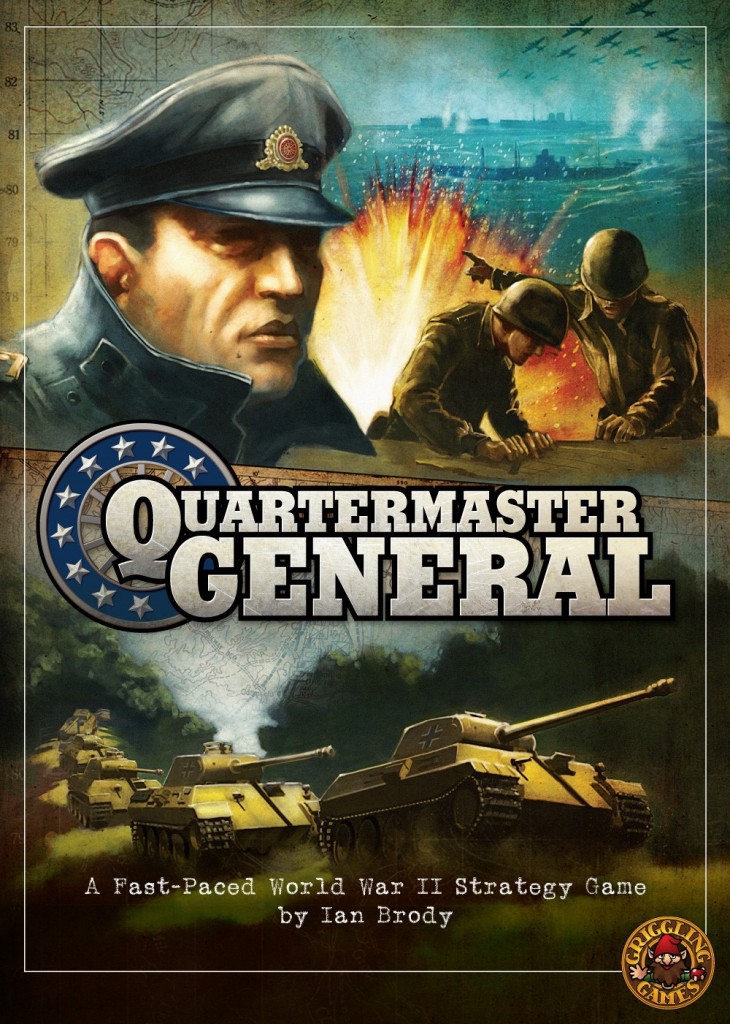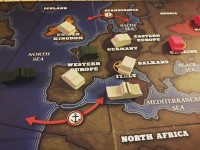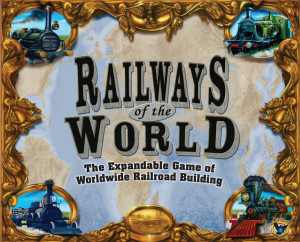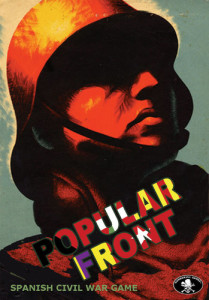- Learning time
- 30 minutes
- First play time
- 120 minutes
Quartermaster General
Designed by: Ian Brody
Quartermaster General is a strategic war game where players take on the Axis and Allied countries of the second world war.
War games often come in the form of long campaigns to be played over many sessions – in contrast Quartermaster General more resembles a family board game in its ease of play and relatively brief duration (if not its theme).
Depending on how many people are playing, players will represent between one and three countries (in a two player game, for instance, opponents will be play Germany/Italy/Japan versus UK/US/USSR). Each player starts with an army in their home country on the board (a map of the world) and a deck of cards that are particular to that country: each country has different strengths and weaknesses. Play proceeds very simply: on your turn you play a card from your hand, and do the action on that card.
Cards can be the following: Build a Navy, Build an Army, Land Battle, Sea Battle, Event, Status, Economic Warfare, and Response. The first four cards are probably self-evident, though you can only build or battle in a region you are adjacent to. Battles couldn’t be simpler to resolve – the person who plays the card wins and the attacked player removes their army/navy from the board (unless they have an appropriate Response card; more of which in a moment). Event cards are based on actual moments during the original conflict, and they allow you to momentarily ‘break’ the basic rules. Status cards give you bonus points depending on your presence on the board, Economic Warfare cards hit opponents with minor penalties and give you a one-off bonus, and Response cards are played face-down, to be revealed at a later moment of your choosing.
Having played a card of your choosing, you score points for territories you’re in on the board (Supply territories that are marked by a gold star, plus any bonuses for Status cards) and check your armies and navies are in supply – that means they must have a clear chain back to a Supply territory, and navies must also be adjacent to land with a ‘friendly’ army on. Any troops not in supply are lost.
You then replenish your hand up to seven cards – you can also choose to discard cards from your hand before replenishing, but beware! Once you’re out of cards that’s it – and some countries have fewer cards than others, so managing your hand is key.
Play continues until either 20 rounds have been played, or one side have captured two home territories of the other side.
The guru's verdict
-
Take That!
Take That!
There's a lot of Take That in war, but at least there is the potential here to be working as a team and sharing the pain (exceptions: with 2 or 3 players at least one person will be working alone)
-
Fidget Factor!
Fidget Factor!
For a game representing such complex and combative times, Quartermaster General plays incredibly fast. You play a card, action it, move on!
-
Brain Burn!
Brain Burn!
Your choices will be dictated by the cards, but you also need to watch what your opponents are up to.
-
Again Again!
Again Again!
There's a lot variation available in terms of tactics, and players can try their hand at being different countries, or even play both sides (i.e., two games) and total up their cumulative scores for an overall winner.










Sam says
What Quartermaster General has going for it is that it takes a theme - World War II - that has spawned hundreds of rule-heavy and time-consuming behemothic games, and condenses it down into 90 minutes - and fast 90 minutes at that. Rules are simple and the graphics of the game are, to me, good. The down-side is that it can feel both repetitive and occasionally merciless - if you're stuck in a bad position and don't pick up the cards to help you out, then it can feel you're watching the game pass you by. However, this is counter-balanced by the fact you do have allies, and if they do their job they'll come and help you out. For me it's a solid game rather than a brilliant one, but I do like it.